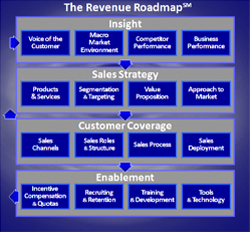The Critical Role of Role Clarity in Sales Success

In a national retail setting, sales representatives were initially responsible for handling all wireless transactions, creating long wait times and frustrating customers. The support staff, originally hired for inventory management and other operational duties, were underutilized and had outdated job descriptions that no longer fit the stores’ needs. Recognizing this inefficiency, a regional leader created a pilot to redefine the support role to handle non-sales tasks within the wireless transaction process, freeing up sales reps to serve more customers directly. As success in the test grew, talent acquisition altered the candidate profile to meet the modified job responsibilities for the position, and a newly trained group of support reps were hired. The impact was immediate: customer satisfaction rose, sales reps increased their close rates and customer accounts, and labor costs were reduced across the market territory.
This example highlights a crucial but often overlooked component of effective sales strategy—role clarity. As companies grow and adapt, roles can become blurred, creating inefficiencies, missed revenue and retention opportunities, and employee frustration. While sales compensation is often the focus of performance improvement discussions, compensation alone rarely addresses these foundational issues. Before exploring pay structures, it’s essential to establish role clarity, especially within the sales organization.
Role clarity not only drives financial outcomes by aligning employee efforts with business goals, but it also has a profound impact on employee satisfaction, engagement, and overall effectiveness.
![]()
How Does it Happen?
Role misalignment to business outcomes typically builds over time. Often the miss is driven by three changes: a shift in business strategy due to changes in the industry or competitive positioning, mergers and acquisitions, and related company reorganizations.
After a series of acquisitions, a private equity (PE) backed firm merged several niche companies under a single umbrella to form a diversified technology services provider. The goal was to leverage the expanded portfolio and generate growth by selling multiple product lines to existing customers. However, a significant challenge emerged: the sales force was segmented by product line, with each salesperson specializing in only one specific product or service.

The firm aimed to improve cross-product selling to existing accounts. The logic was simple: existing customers who already trusted the company could be ideal candidates for additional products, thus increasing revenue without the higher costs of new customer acquisition. To capitalize on this, management directed the single-product sales teams to promote the broader product suite in their conversations with clients.
However, the sales reps faced immediate obstacles. They had been hired and trained exclusively to sell a specific product. For example, the team responsible for selling the company’s cybersecurity software had deep expertise in IT security but lacked knowledge of the recently acquired cloud solutions product line. Without familiarity or training in the additional products, these sales reps were hesitant and unprepared to introduce them to their clients. Their attempts to discuss other offerings often felt forced or inauthentic, and clients quickly sensed the reps’ lack of confidence and expertise.
In another case, a national telecommunications company, under intense competitive pressure from new market entrants, was challenged to boost revenue quickly while cutting operational expenses. Senior leadership set aggressive targets to capture market share by selling bundled services, such as internet, cable, and security packages, to both new and existing customers. To achieve these ambitious goals, they pushed for aggressive upselling by the sales team and streamlined costs by consolidating service roles.
Leadership’s strategy was to leverage sales reps as multipurpose revenue drivers, not only closing deals but also taking on tasks traditionally handled by the service team, such as onboarding new clients and providing account management support. The rationale was straightforward: since sales reps were already client-facing, they could “own” the customer relationship end-to-end, from initial sale to ongoing support. This approach, leadership believed, would improve the client experience by creating a single point of contact and reduce costs by eliminating redundancies between the sales and service teams.
Initially, the strategy seemed to work. Sales reps started selling higher-value packages with ease, as they had deeper insights into each client’s needs. Service costs appeared to decline, with fewer personnel needed to manage accounts post-sale. However, as sales volume ramped up, cracks in the approach started to appear.
Sales reps were now responsible not only for closing new business but also for handling onboarding, technical troubleshooting, and periodic client check-ins. What had initially seemed like a way to enhance the client experience quickly overwhelmed the sales team. Sales reps, whose skills lay in closing deals, struggled with the added responsibility of account management, resulting in a slower sales cycle and decreased morale as they were stretched too thin.
With sales reps bogged down by service responsibilities, new business development began to suffer. The pressure to manage ongoing client accounts meant less time spent prospecting and nurturing leads. Potential cross-sell and upsell opportunities were also missed, as sales reps focused on resolving client issues rather than identifying new sales prospects within their accounts. Revenue growth slowed, and the company fell short of its aggressive targets.
![]()
Why Role Clarity Matters
In an ideal organization, each employee would clearly understand their role, responsibilities, and the outcomes they are expected to achieve. This alignment not only supports the company’s financial performance but also directly influences employee engagement and satisfaction.
![]()
Business and Financial Impacts on Role Clarity
Enhanced Efficiency and Cost Management: When roles are well-defined, teams can avoid redundant responsibilities and optimize staffing, often leading to reduced hiring costs and streamlined operations.

In our national retail scenario, redefining the support staff role to offload non-sales tasks from the sales reps allowed the company to optimize staffing, increase customer satisfaction, and improve the bottom line.
Alignment with Business Goals: Role clarity ensures that employees’ activities are directly aligned with company goals, such as expanding account revenue or achieving specific growth targets. A misalignment between roles, objectives, and sales compensation can lead to underperformance and missed revenue opportunities.
In a company with a broad product portfolio, both the Account Executive (AE) and Delivery Manager (DM) roles were responsible for renewals, but only the DM compensation was tied to this outcome. This lack of alignment led to disengagement from the AE after the initial sale, which resulted in missed cross-sell opportunities and increased vulnerability to competitors.
The company underwent a rigorous review of their sales compensation plans, aligning the expected outcomes to their strategic goals. With new plans in hand, they implemented a thorough training program that explained their goals, how the AE and DM roles would contribute to meeting those goals and gained their buy in to their new compensation plans.
Now with the roles and compensation plan both aligned to expected growth outcomes, the teams were able to ramp up to deliver improved retention, increased customer satisfaction, and diversified revenue that historically had not been significant in total revenues.
![]()
Employee Impacts on Role Clarity
Improved Engagement and Reduced Attrition: Employees who understand their responsibilities feel more empowered and are better positioned to succeed. Ambiguity in role expectations can lead to dissatisfaction and turnover.
In a professional services firm, a new Account Executive role was introduced to “quarterback” large accounts and drive both new and cross-sell opportunities. However, without clear support from senior leaders and defined boundaries, the AEs were unable to fulfill this quarterbacking role and instead functioned as additional team members. This lack of clarity led to attrition, unachieved revenue goals, and dissatisfaction among the team, as the role was misaligned with the initial hiring expectations.
To address these challenges, the company implemented a structured change management strategy to clarify the AE role, starting with leadership alignment. The plan provided specific guidance on how departments could continue focusing on their individual product lines while leveraging AEs to boost revenue and foster cross-product stickiness, ultimately improving overall corporate health.
Department leaders began including AEs in strategy discussions, client reviews, and meetings, which created alignment across teams. As a result, the role’s expectations were clarified, and AE attrition normalized, contributing to stronger engagement and improved outcomes for the organization.
Increased Job Satisfaction and Performance: Clear roles reduce stress and confusion, leading to higher job satisfaction. Employees know where they stand, which helps them focus on specific objectives and excel in their areas of expertise.
In the instance of the national retail support role referenced earlier, now seeing a career path and the integral role it was playing in driving stores’ performance, employees in the reimagined role showed significant improvement in not just Employee Net Promoter Score (eNPS), but also in application for sales roles as a career path.
![]()
Real Consequences of Poor Role Clarity
Lack of role clarity can have widespread and measurable financial impacts across an organization and can also present other unwanted challenges.
Financial Costs and Missed Opportunities: Ambiguous roles often result in over-hiring or misallocation of resources, directly affecting the bottom line. Employees operating without clear responsibilities may neglect essential tasks or misalign their efforts, leading to missed sales opportunities, reduced labor efficiencies and can even present legal challenges.
In one recent case, attestation surveys revealed that employees were performing only 20% of the duties outlined in their job descriptions. This discrepancy raised significant concerns, including compensation fairness and questions such as, “Am I being paid for what I’m actually doing?” and “Does my manager understand my role?” Such misalignment can also create costly legal risks, particularly if employees are tasked with responsibilities outside their role or pay grade, impacting both morale and compliance with labor laws.
The misalignment can cause an organization to look under-staffed when in reality, the headcount to deliver the required results may be there, but the work is not aligned with those employees. Often this is realized in the form of the “Somebody, Anybody, Everybody, and Nobody” syndrome, where critical work is neglected because everyone assumes someone else is handling it. This dynamic can lead to significant revenue losses and a lasting negative impact on financial results.
Operational Inefficiencies and Customer Dissatisfaction: Without clearly defined roles, responsibilities may overlap, or critical tasks may go unassigned, leading to inefficiencies. This is particularly problematic in client-facing roles, where ambiguity over ownership of tasks can frustrate clients and damage relationships.
In our earlier example, when both the Account Executive (AE) and Customer Success Manager (CSM) assumed responsibility for client renewals, the lack of a clear primary contact led to clients receiving inconsistent information. This confusion impacted customer satisfaction, as clients felt underserved due to gaps in communication and service. Conversely, clearly delineated roles ensure clients know their main contact, and internal teams can collaborate more effectively.
![]()
Role Clarity as the Foundation for Sales Effectiveness
At SalesGlobe, we use a model called the Revenue Roadmap to support holistic sales effectiveness. This framework includes four key competencies:

Revenue Roadmap
- Insight: A comprehensive understanding of customers, market trends, and internal metrics.
- Sales Strategy: Defined goals for customer focus, product focus, and revenue targets.
- Customer Coverage: Establishing sales roles, routes to market, and a consistent sales process.
- Enablement: Supporting teams with recruitment, training, technology, and incentives.
Of these, Customer Coverage often presents the most opportunity for revenue growth improvements. For instance, when a salesperson’s role includes expanding account revenue, but their incentive structure does not align with this goal, role misalignment leads to frustration and missed opportunities. Compensation plans that reinforce well-defined roles and desired outcomes allow salespeople to focus on achieving specific business objectives without distraction.
![]()
The Power of Clarity in Collaborative Roles
In roles that require collaboration, such as between Account Executives and Customer Success Managers, clarity around responsibilities is crucial to prevent role conflicts. This clarity minimizes overlaps, streamlines processes, and enhances both team and customer experiences.
Using our example from earlier, the company struggling with collaboration between Account Executives (AEs) and Customer Success Managers (CSMs) found that both roles were responsible for certain client touchpoints without clear delineation. This ambiguity led to either disengagement or duplication of work and ended with client confusion. By defining the AE as the primary point of contact for new, penetration and renewal revenue for the account and the CSM for ongoing account support, the company improved both internal workflow and client satisfaction, as clients now had a clear and dependable contact for each stage of the relationship, and when paired with a compensation plan alignment to the newly delineated roles, revenue grew.
![]()
The Benefits of Role Clarity
Clear role definitions help companies improve both business outcomes and employee satisfaction. Specifically:
Business/Financial Benefits:
- Reduced costs through optimized staffing and minimized redundancies.
- Improved sales performance by aligning incentives with specific roles and business goals.
- Enhanced customer satisfaction by providing clients with a clear, consistent point of contact.
Employee Benefits:
- Increased job satisfaction, as employees understand what’s expected of them and are empowered to succeed.
- Higher engagement and retention rates, as employees are more likely to stay when they feel their role is aligned with both their strengths and company goals.
Enhanced collaboration and reduced conflict, as clear roles eliminate the confusion of overlapping responsibilities.
![]()
Role clarity is a cornerstone of sales success. By clearly defining responsibilities and aligning compensation structures, companies can reduce redundancy, focus employee efforts, and drive better customer outcomes. Implementing role clarity not only boosts business performance but also improves employee satisfaction, creating a strong foundation for sustainable growth.
![]()
SalesGlobe is a leading sales effectiveness and data-driven creative problem-solving firm. We specialize in helping Global 1000 companies solve their toughest growth challenges and helping them think in new ways to develop more effective solutions in the areas of sales strategy, sales organization, sales process, sales compensation, and quotas. We wrote the books on sales innovation with The Innovative Sale, What Your CEO Needs to Know About Sales Compensation, and Quotas! Design Thinking to Solve Your Biggest Sales Challenge.

Senior Consultant – Sales Effectiveness with SalesGlobe
Results-driven executive skilled in strategic sales, revenue optimization, and team empowerment for sustainable growth.




